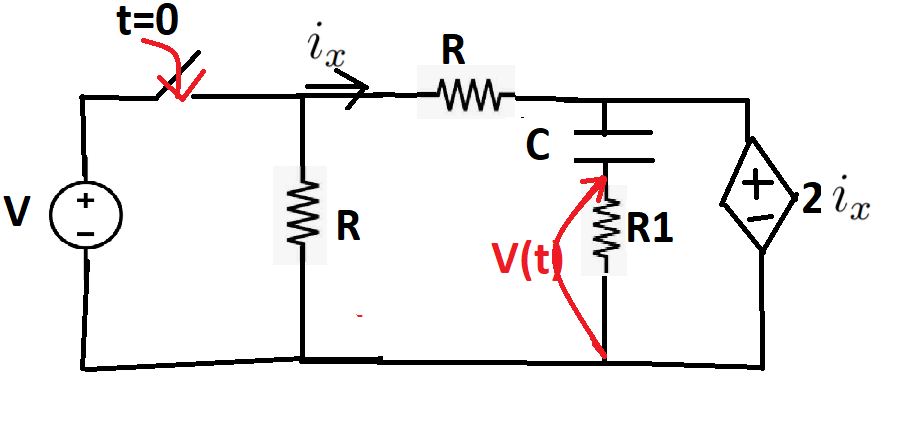Let us initially address your inquiry: The initial currents and voltages across all components are equal to zero for \$t<0\$, as \$2\text{I}_x\$ is contingent upon \$\text{I}_x\$, and it becomes evident that \$\text{I}_x=0\$ for \$t<0\$.
Well, we are trying to analyze the following circuit:

simulate this circuit – Schematic created using CircuitLab
When we use and apply KCL, we can write the following set of equations:
$$
\begin{cases}
\begin{alignat*}{1}
\text{I}_\text{i}&=\text{I}_1+\text{I}_2\\
\\
\text{I}_3&=\text{I}_0+\text{I}_2\\
\\
\text{I}_1&=\text{I}_\text{i}+\text{I}_4\\
\\
\text{I}_0&=\text{I}_3+\text{I}_4
\end{alignat*}
\end{cases}\tag1
$$
When we use and apply Ohm's law, we can write the following set of equations:
$$
\begin{cases}
\begin{alignat*}{1}
\text{I}_1&=\frac{\displaystyle\text{V}_\text{i}-0}{\displaystyle\text{R}_1}\\
\\
\text{I}_2&=\frac{\displaystyle\text{V}_\text{i}-\text{n}\cdot\text{I}_2}{\displaystyle\text{R}_2}\\
\\
\text{I}_3&=\frac{\displaystyle\text{n}\cdot\text{I}_2-\text{V}}{\displaystyle\text{R}_3}\\
\\
\text{I}_3&=\frac{\displaystyle\text{V}-0}{\displaystyle\text{R}_4}
\end{alignat*}
\end{cases}\tag3
$$
Substitute \$(2)\$ into \$(1)\$, in order to get:
$$
\begin{cases}
\begin{alignat*}{1}
\text{I}_\text{i}&=\frac{\displaystyle\text{V}_\text{i}-0}{\displaystyle\text{R}_1}+\frac{\displaystyle\text{V}_\text{i}-\text{n}\cdot\text{I}_2}{\displaystyle\text{R}_2}\\
\\
\frac{\displaystyle\text{n}\cdot\frac{\displaystyle\text{V}_\text{i}-\text{n}\cdot\text{I}_2}{\displaystyle\text{R}_2}-\text{V}}{\displaystyle\text{R}_3}&=\text{I}_0+\frac{\displaystyle\text{V}_\text{i}-\text{n}\cdot\text{I}_2}{\displaystyle\text{R}_2}\\
\\
\frac{\displaystyle\text{V}_\text{i}-0}{\displaystyle\text{R}_1}&=\text{I}_\text{i}+\text{I}_4\\
\\
\text{I}_0&=\frac{\displaystyle\text{n}\cdot\frac{\displaystyle\text{V}_\text{i}-\text{n}\cdot\text{I}_2}{\displaystyle\text{R}_2}-\text{V}}{\displaystyle\text{R}_3}+\text{I}_4\\
\\
\frac{\displaystyle\text{V}-0}{\displaystyle\text{R}_4}&=\text{I}_0+\frac{\displaystyle\text{V}_\text{i}-\text{n}\cdot\text{I}_2}{\displaystyle\text{R}_2}\\
\\
\text{I}_0&=\frac{\displaystyle\text{V}-0}{\displaystyle\text{R}_4}+\text{I}_4
\end{alignat*}
\end{cases}\tag3
$$
Now, let's solve for \$\text{V}\$:
$$\text{V}=\frac{\displaystyle\text{V}_\text{i}\text{n}\text{R}_4}{\displaystyle\left(\text{n}+\text{R}_2\right)\left(\text{R}_3+\text{R}_4\right)}\tag4$$
Now, applying this to your circuit we need to use (from now on I use the lower case letters for the function in the 'complex' s-domain where I used Laplace transform):
- $$\text{R}_3=\frac{\displaystyle1}{\displaystyle\text{sC}}\tag5$$
- The input voltage is a stable DC voltage equal to \$\hat{\text{u}}\$, so:
$$\text{v}_\text{i}\left(\text{s}\right)=\frac{\displaystyle\hat{\text{u}}}{\displaystyle\text{s}}\tag6$$
So, we get:
$$\text{v}\left(\text{s}\right)=\frac{\displaystyle\frac{\displaystyle\hat{\text{u}}}{\displaystyle\text{s}}\cdot\text{n}\text{R}_4}{\displaystyle\left(\text{n}+\text{R}_2\right)\left(\frac{\displaystyle1}{\displaystyle\text{sC}}+\text{R}_4\right)}\tag7$$
Taking the inverse Laplace transform, leads to:
$$\text{V}\left(t\right)=\frac{\displaystyle\text{n}\hat{\text{u}}}{\displaystyle\text{n}+\text{R}_2}\cdot\exp\left(-\frac{\displaystyle t}{\displaystyle\text{CR}_4}\right)\tag8$$




can we assume that the voltage across the capacitor and the resistance initially is 0?- be precise here. \$\endgroup\$